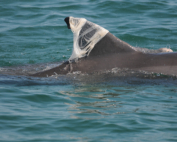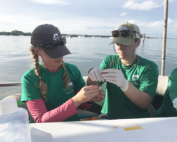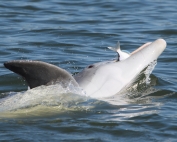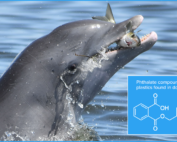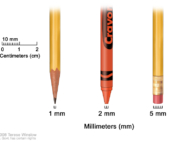Dolphins Living Near Urban Coastline Show More Frequent Exposure to Chemicals from Plastics than those in Rural Area
New study compared concentrations of endocrine-disrupting compounds between dolphins from Sarasota Bay, Florida, and Barataria Bay, Louisiana

Dr. Leslie Hart, Associate Professor at the College of Charleston (left) and Miranda K. Dziobak, of the College of Charleston and the University of South Carolina, process a control sample to help ensure chemicals in dolphin urine aren’t coming from lab tools or background contamination. Photo credit: HOPE Research Lab | College of Charleston
Dolphins that live near urban coastlines appear to be exposed more frequently to chemicals associated with plastics — called phthalates — than those living near more rural areas, according to findings from a new study published in the peer-reviewed journal Frontiers in Marine Science.
Phthalates are chemicals used to make plastics more flexible, durable, and to function as solvents and stabilizers. They’ve been nicknamed the “everywhere chemical” because they’re so widespread in our daily lives. These chemicals, which are easily released into the environment as plastics break down, are found in everything from PVC pipes, to food packaging to cosmetics and even perfumes. Exposure is so common that more than 95 percent of humans have detectible levels in their urine.
These ubiquitous chemicals are known endocrine disruptors that impact mammals’ hormone systems, which can cause problems with growth, fertility and reproduction. Human studies have also shown that phthalates can lead to heart problems and even neurological disorders.
Since 2016, Brookfield Zoo Chicago’s Sarasota Dolphin Research Program (SDRP) and The College of Charleston have been studying signs of plastic pollution exposure in Sarasota Bay dolphins. Using methods similar to those in human health studies, researchers first looked at whether there was evidence of phthalates in dolphin urine. Findings showed widespread exposure to these chemicals: 75% of Sarasota Bay dolphins are exposed to phthalates, and they have much higher levels of some of these chemicals than humans.
This newest study, “Comparing phthalate exposure between bottlenose dolphins (Tursiops truncatus) residing in urban and rural environments,” compared phthalate concentrations in the urine of dolphins living in Sarasota Bay, Florida, which is adjacent to a highly developed, urbanized community, to dolphins living in Barataria Bay, Louisiana — a much more rural, less populated area where the dolphin population has been closely studied because it was impacted by the Deepwater Horizon oil spill.
They found that 73 percent of the Sarasota Bay dolphins had detectable phthalate levels compared to 33 percent in Barataria Bay dolphins, though the concentration levels in both populations were similar. There were also differences in the types of phthalates detected.
Urine samples in both dolphin populations had detectable concentrations of mono-2-ethylhexyl phthalate (MEHP) exposure, while only the samples from the dolphins in Sarasota Bay revealed exposure to monoethyl phthalate (MEP). MEHP is commonly associated with plastic products, such as PVC and food packaging, while MEP is commonly linked to personal care products, such as perfumes and fragranced lotions.
“That we found MEHP in both populations suggests the widespread nature of plastic pollution, while the MEP found only in the Sarasota Bay dolphins points to an association with greater human activity,” said the study’s lead author, Miranda K. Dziobak, of the College of Charleston and the University of South Carolina. “Both are concerning because we know that these chemicals are endocrine disruptors and if they affect dolphin reproduction, that could have population-level impacts on dolphin communities.”
The SDRP is the world’s longest-running dolphin conservation research program. The research team studies the biology, behavior, ecology, social structure, health, and communication of dolphins, as well as the effects of human activities on them. The dolphins often serve as a reference population for dolphins in other locations, such as Barataria Bay, where previous studies have focused on the impacts of the Deepwater Horizon oil spill.
Those studies have produced concerning results indicating that the oil-exposed dolphin population there declined by 45 percent after the spill and that it remains vulnerable to emerging threats like those posed by phthalates, said Dr. Randy Wells, Director of the SDRP, which has been operated by Brookfield Zoo Chicago since 1989.
“For long-lived species like dolphins, small changes in individual survival can result in big changes for a population,” Wells said. “And because there are no proven medical interventions that we can implement to address persistent diseases caused by oil exposure, resource managers have to prevent additional impacts from things that we can control. It’s important to understand how chemicals like phthalates leaching into our aquatic ecosystems are impacting the animals there so we can address them.”
Studies of phthalate impacts on dolphins are ongoing and, with funding from Sea Grant (Award No. NA22OAR4170655 – CFDA #11.417), researchers are currently looking at whether environmental factors — specifically rainfall, large storm events, and harmful algal blooms — have any effect on contaminant levels in dolphins, according to Dr. Leslie Hart, Associate Professor at the College of Charleston, who has been leading the dolphin-phthalate studies in partnership with the SDRP since 2016.
“Because the Sarasota Bay dolphin community is so well known and so well studied — and it’s a relatively healthy population — it can serve as a reference population to help us better understand health differences in other places, like Barataria Bay,” Hart said. “And with 55-plus years of data on the Sarasota dolphins themselves, we can also address new questions as they emerge.”

Bottlenose dolphin study sites: Sarasota Bay, Florida and Barataria Bay, Louisiana. Image credit: Map created using Esri ArcGIS Pro basemap, Esri, TomTom, Garmin, FAO, NOAA, USGS | © OpenStreetMap contributors, and the GIS User Community.
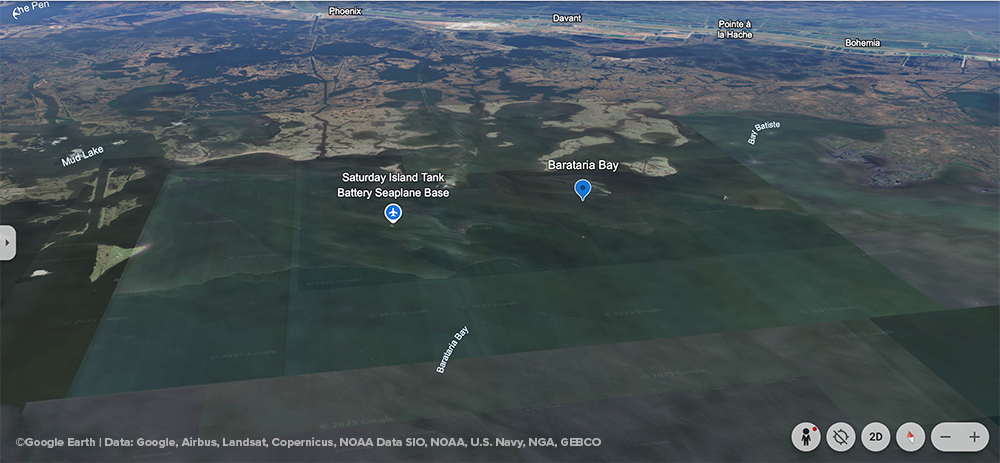
Google Earth shows the lack of land-side development surrounding Barataria Bay, Louisiana. According to the U.S. Census, the population there is 1,005. Image cedit: Google, Airbus, Landsat, Copernicus, NOAA, Data SIO, NOAA, U.S. Navy, NGA, GEBCO

Google Earth shows the development surrounding Sarasota Bay, which is home to a dolphin community of about 160 animals that call the Bay home year ‘round. According to the U.S. Census, there are about 55,000 residents in the community surrounding the Bay. Image credit: Google, Landsat, Copernicus, Data SIO, NOAA, U.S. Navy, NGA, GEBCO, Airbus
— Research reported in this publication was supported by the National Institute of Environmental Health Sciences of the National Institutes of Health under Award Number R15ES034169. The content is solely the responsibility of the authors and does not necessarily represent the official views of the National Institutes of Health.
Citation
Dziobak MK, Curtin T, Wells RS, Takeshita R, Smith CR, Zolman E, Toms CN, Allen RF and Hart LB (2025) Comparing phthalate exposure between bottlenose dolphins (Tursiops truncatus) residing in urban and rural environments. Front. Mar. Sci. 12:1554075. doi: 10.3389/fmars.2025.1554075
Read More
Reducing Plastics and Phthalates in the Environment
Help Wild Dolphins and Other Marine Life by Reducing Plastics and Phthalates in Your Life More than 170 trillion plastic particles end up in our oceans annually where they impact marine life
Plastics in Rural and Urban Dolphins
Dolphins Living Near Urban Coastline Show More Frequent Exposure to Chemicals from Plastics than those in Rural Area New study compared concentrations of endocrine-disrupting compounds between dolphins from Sarasota Bay, Florida, and Barataria
Ftalatos y Delfines
¿Los cambios en los patrones climáticos expondrán a los delfines a más sustancias químicas? Un estudio en la bahía de Sarasota, Florida, tiene como objetivo comprender si el exceso de lluvias y las
Phthalates and Dolphins
Will Changing Weather Patterns Expose Dolphins to More Chemicals? Sarasota Bay, Florida, study aims to understand whether excess rainfall and red tides impact the concentration of chemical contaminants in dolphins
Microplastics Detected in Dolphin Breath
Every Breath They Take? New Study Suggests Dolphins are Inhaling Plastics A member of the SDRP research team holds a petri dish over a dolphin's blowhole to collect a breath
A Tangled Food Web
Paper Provides New Insights on How Microplastics are Moving From Prey to Predator A new research paper based on studies conducted in Sarasota Bay is providing insights on how microplastics are moving
Stow it! Don’t Throw It!
Creating Monofilament Collectors to Help Save Dolphins from Entanglement Did you know that monofilament fishing line can take up to 600 years to decompose and that it
Plastic and Plastic Compounds in Dolphins
Studying the Impacts of Plastics and Plastic Compounds in Sarasota Bay Dolphins The oceans are estimated to contain more than 170 trillion plastic particles — with more
Dolphins and Microplastics
Study Finds Evidence that Dolphins are Ingesting Microplastics A new study in the peer-reviewed journal Frontiers in Marine Science has found evidence that members of the Sarasota Bay dolphin community are inadvertently ingesting
Join Our Marine Debris Team
One of the simplest ways to help wild dolphins — and all other marine life — is to make sure you’re not leaving plastics or other trash in our waterways or allowing garbage to




